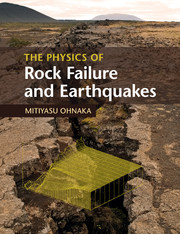Book contents
- Frontmatter
- Contents
- Preface
- 1 Introduction
- 2 Fundamentals of rock failure physics
- 3 Laboratory-derived constitutive relations for shear failure
- 4 Constitutive laws for earthquake ruptures
- 5 Earthquake generation processes
- 6 Physical scale-dependence
- 7 Large earthquake generation cycles and accompanying seismic activity
- List of illustration credits
- References
- Index
3 - Laboratory-derived constitutive relations for shear failure
Published online by Cambridge University Press: 05 April 2013
- Frontmatter
- Contents
- Preface
- 1 Introduction
- 2 Fundamentals of rock failure physics
- 3 Laboratory-derived constitutive relations for shear failure
- 4 Constitutive laws for earthquake ruptures
- 5 Earthquake generation processes
- 6 Physical scale-dependence
- 7 Large earthquake generation cycles and accompanying seismic activity
- List of illustration credits
- References
- Index
Summary
Method and apparatus used
In order to establish the constitutive law for the shear failure (or fracture) of intact rock in the brittle to semi-brittle (or brittle–plastic transition) regimes under seismogenic crustal conditions, it is necessary to carefully observe the entire shear failure process during which the post-failure (or slip-weakening) behavior is stabilized. A sophisticated high-pressure testing apparatus having a stiff loading frame and electronic servo-controls with a 16-bit resolution digital system was constructed for this purpose in our laboratory at the Earthquake Research Institute, the University of Tokyo (Ohnaka et al., 1997). The post-failure behavior can be stabilized even in the brittle regime by enhancing the stiffness of the loading system and properly choosing servo-control variables.
The entire system includes the load frame assembly with which servo-hydraulic actuators are integrated, a triaxial pressure cell, servo-hydraulic intensifiers (for confining pressure and pore pressure), a hydraulic power supply system, a heater and cascade temperature controller, a water cooling system, and a computer-automated system controller with software designed for use with multiple channel servo-hydraulic valves and a heater (for details, see Ohnaka et al., 1997).
- Type
- Chapter
- Information
- The Physics of Rock Failure and Earthquakes , pp. 28 - 90Publisher: Cambridge University PressPrint publication year: 2013



